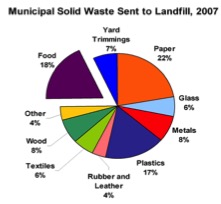In an effort to continue to highlight sustainable and innovative technologies, processes and strategies that are moving our water industry into the future, the NEWEA Sustainability Committee decided to offer a regular newsletter vignette focused on such topics. We hope that through our offerings you might find yourself informed of something new, interested in applying within your organization, or merely just intrigued at the new and interesting happenings within our every changing industry.
What are the sustainable opportunities with co-digestion?
The Sustainability Committee hosted a technical session at the 2018 Annual Conference focused on the challenges and opportunities of co-digestion. Why the focus on this innovative process? In an effort to reduce food waste and enhance resource recovery, states and cities across the country are enacting legislation to cut down on the amount of food and organic waste sent to landfills. Estimates show organic wastes accounting for 15 to 20% of our national waste characterization. That same organic waste has significant energy potential producing on average 3 times that of wastewater biosolids. These recent organics laws are forcing large waste generators like grocery stories and hospitals to donate or send their leftover food to composting sites, animal-feed operations, or anaerobic digestion facilities. While these laws are restricting large waste generators, they are also opening new opportunities for wastewater treatment facilities to implement co-digestion programs at their facilities.
Co-digestion is feasible for any wastewater treatment facility already equipped with anaerobic digesters that might have excess capacity or those facilities considering the addition of anaerobic processes. Wastewater facilities can gain the most direct benefit from co-digestion through improved quality and quantity of digester by-products, namely biogas and biosolids. Food waste tends to have a larger methane content than wastewater sludge that speeds up microbial activity resulting in an increase in biogas output and more energy rich biosolids. If facilities are currently harnessing or selling these byproducts (i.e., energy and biosolids), co-digestion could increase profits and/or renewable energy production.
Additionally, wastewater facilities that are in states or near cities who have food bans in place can gain extra income through tipping fees from waste generators. As food waste bans become more mainstream, additional funding sources will likely be available to facilities looking to create a co-digestion program at their facility. Finally, this process creates a synergistic use of a waste product that is otherwise considered a community nuisance and reaps a benefit in additional community resources (i.e., renewable energy).
What’s holding co-digestion back?
While co-digestion of organics and wastewater solids seems on the surface to be a great idea, as with any newer process, there are significant upfront costs and a high amount of uncertainty that need to be addresses. One key concern is the quality of the incoming food waste and the impact it could have on biosolids and recycled streams. Facilities located near areas affected by food bans may have access to more homogenous waste sources, but it will be nearly impossible to insure a truly consistent source. To prepare to intake organic matter, facilities may need to install a pretreatment system to make the waste more homogeneous. Currently, there are many pretreatment technologies on the market, but little comparative information on performance and cost. The Water Research Foundation has made it their goal to provide utilities with information and tools to make informed decisions about pre-treatment and management practices by 2022, making this challenge more manageable soon.
Some of the more practical challenges surrounding co-digestion center around storage of excess food waste and minimization of odor and vector populations. While these issues may seem small, it can add an additional layer of maintenance for facilities to manage.
What are the next green steps?
As the long-term sustainability of existing landfills continues to decline, especially in areas of significant and growing populations, co-digestion of organics with wastewater solids may become increasingly viable from both an economic as well as environmental and societal perspective. This is a process that existing wastewater facilities and operations should consider when planning for future upgrades or capital improvement projects.




No comments yet.